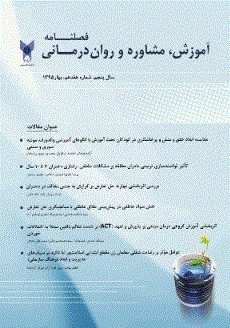مقایسه ابعاد خلق و منش و پرخاشگری در کودکان تحت آموزش با الگوهای آموزشی والدورف، مونته سوری و سنتی
محورهای موضوعی : فصلنامه تعالی مشاوره و روان درمانیآزاده فرقدانی 1 * , فاطمه شاطریان محمدی 2 , مهین زیادبخش 3
1 - عضو هیات علمی تمام وقت دانشگاه آزاد اسلامی واحد ساوه
2 - استادیار دانشگاه آزاد واحد ساوه
3 - فارغ التحصیل دانشگاه آزاد واحد ساوه کارشناسی ارشد روانشناسی تربیتی
کلید واژه: پرخاشگری, خلق و منش, مونته سوری, والدورف,
چکیده مقاله :
چکیده پژوهش حاضر با هدف مقایسه ابعاد خلق و منش و پرخاشگری در کودکان پیشدبستانی تحت آموزش با الگوهای آموزشی والدورف،مونته سوری و سنتی در قالب طرح پس رویدادی،انجام شده است.جامعه پژوهش را کلیه مراکز پیش دبستانی منطقه 2 تهران تشکیل داده اند که بر اساس الگوهای آموزشی مذکور اداره می شوند.ابتدا از بین این مراکز،6 مرکز( دو مرکز منطبق با هر الگو) انتخاب شد و پرسشنامه کیفیت مراقبت مادرانه به منظور کنترل متغیر روابط مادر- کودک و همتاسازی کودکان در این مولفه بر روی مادران اجرا شد.در نهایت،تنها مادرانی که بالاترین نمره را در این پرسشنامه کسب کرده بودند،انتخاب شدند.بنابراین در مرحله دوم به منظور ارزیابی خلق ومنش و پرخاشگری کودکان,پرسشنامه هفت عاملی خلق و منش کنستانتینو(2002)و پرسشنامه چهار عاملی پرخاشگری کودکان پیش دبستانی واحدی وهمکاران(1387)در اختیار مربیان کودکانی قرار گرفت که مادران آنها از نظر کیفیت مراقبت مادرانه مشکلی نداشتند.پس از پاسخگویی مربیان به پرسشنامه های خلق و منش وپرخاشگری کودکان وابراز نظر آنها در مورد این کودکان،درنهایت تحلیل دادهها بر روی 90کودک(15کودک از هر مرکز)صورت گرفت.تحلیل واریانس چندمتغیری دادههاحاکی از بالاتر بودن خشم کلامی–تهاجمی و فیزیکی–تهاجمی در کودکان الگوی سنتی در مقایسه با مونتهسوری و والدورف بود.همچنین در ابعاد خشم بین نمرات کودکان الگوهای مونته-سوری و والدورف تفاوتی وجود نداشت.درمتغیر خلق و منش،نوجویی وپافشاری(ابعاد خلقی)و خودهدایتگری وهمکاری(ابعاد منش)در کودکان الگوی والدورف بالاتر از مونتهسوری و سنتی بود.همچنین در ابعاد خلق و منش بین کودکان مونته سوری وسنتی تفاوتی وجود نداشت.نتایج پژوهش،حاکی از اهمیت محیط آموزشی بعد از محیط خانواده در شکلگیری ویژگیهای خلقی و رفتاری کودکان است.
The present study was conducted to compare various dimensions of temperament, character and aggression in preschool children trained with Waldorf,Montessori,and traditional approaches of education. The statistical population included all preschools in Region 2 of Tehran, administered based on the aforementioned educational approaches. In the first stage, six preschools (two preschools for each approach) were selected. Then, the inventory of maternal care quality was administered among mothers to study mother-child relations and match children in this factor. Finally,only mothers who obtained the highest scores in this inventory were selected. In the second stage, the seven-factor preschool temperament and character inventory,developed by Constantino(2012),and the four-factor preschool children aggression inventory ,developed by Vahedi et al. (2008),were given to the instructors of those children with quality caring mothers.After the instructors completed the inventories and their opinions about these children were collected,data pertaining to 90 children (15 children from each preschool) was analyzed. The multivariate analysis of variance of data suggested higher level of verbal and physical aggression in children trained with traditional approach, as compared to two other approaches,the aggression scores of the children trained with Waldorf and Montessori approaches were not different. In addition,children trained with Waldorf approach obtained higher scores than other two groups in novelty seeking and persistence (as two dimensions of temperament),self-directedness,and cooperativeness (as two dimensions of character).The temperament and character scores of the children trained with Montessori and traditional approaches were not different.Findings suggested the importance of educational environment,secondary to family environment,in the formation of temperamental and behavioral characteristics.
_||_

